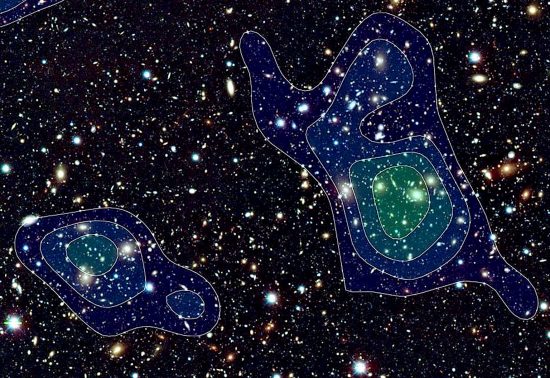
March 20, 2020
Galaxies are electrical entities.
A recent press release reiterates the current maxim among astronomers and astrophysicists: “About eighty-five percent of the matter in the universe is in the form of dark matter…”
Dark matter is the topic of several Pictures of the Day. It is undetectable by any instruments, so investigations into its nature have, thus far, been fruitless. One of the major difficulties with dark matter studies based on modern cosmological ideas is that fundamental forces are gravito-centric; ignoring electrical activity.
Again, quoting the press release: “Galaxies generally reside at the centers of vast clumps of dark matter called haloes because they surround the galaxies. Gravitational lensing of more distant galaxies by foreground dark matter haloes offers a particularly unique and powerful probe of the detailed distribution of dark matter.”
Conventional theories assume that galaxies are born out of gravity, alone. Gravity is an extremely weak force when compared to electromagnetism. A leap from a ten-story building will cause a leisurely acceleration of nine meters per second squared in Earth’s gravity field. However, the electromagnetic fields of the sidewalk are so strong that they stop that acceleration instantly. In fact, they are so resistant that the molecules of the sidewalk do not interpenetrate the molecules of the body on impact. The force fields of the sidewalk are 39 orders of magnitude greater than gravity’s acceleration.
Galaxies exhibit electrical activity, since each star is the locus of electric charge flow. Such flows of electricity are known as Birkeland currents, named after Kristian Birkeland. Electricity in space exists in three forms: dark mode, glow mode and arc mode. The best known is probably arc mode, since that is the condition in which it is most easily seen. Stars are arc mode plasma discharges. However, dark mode discharges, as their name implies, are not readily visible, but they are just as capable of electromagnetic interactions.
A recent Picture of the Day highlighted a phenomenon that is puzzling astrophysicists. Several spacecraft in the Solar System are affected by some power that is retarding their acceleration. A few, such as Pioneers 1 and 2, are off course by several thousand kilometers. Among consensus investigators it is anyone’s guess as to why. However, when Electric Universe principles are considered the mysteries fall away.
Electricity powers galaxies as it moves out of their polar axes and then back through their discs. This means that a circuit exists that receives its energy from Birkeland currents that connect each galaxy with the rest of the Universe. Presumably, billion-light-year long strands of magnetically confined electric filaments are transmitting power from one end of the cosmos to the other.
As previously written, when objects travel through interplanetary space they build-up a negative charge differential with respect to the positive charge of the Sun. Since electric forces scale by many orders of magnitude, the weak, radial electric field of the Milky Way galaxy is most likely doing the same thing to the stars at its outer boundary. No dark matter haloes are needed.
The idea that electricity flows through the Universe is commonly met with resistance by today’s consensus, so its influence and attributes are unseen. It has long been said that “seeing is believing.” It should not be surprising that “believing is seeing” appears to be more apt. When there is no inner experience, outer realities can often remain invisible.
Stephen Smith
The Thunderbolts Picture of the Day is generously supported by the Mainwaring Archive Foundation.












